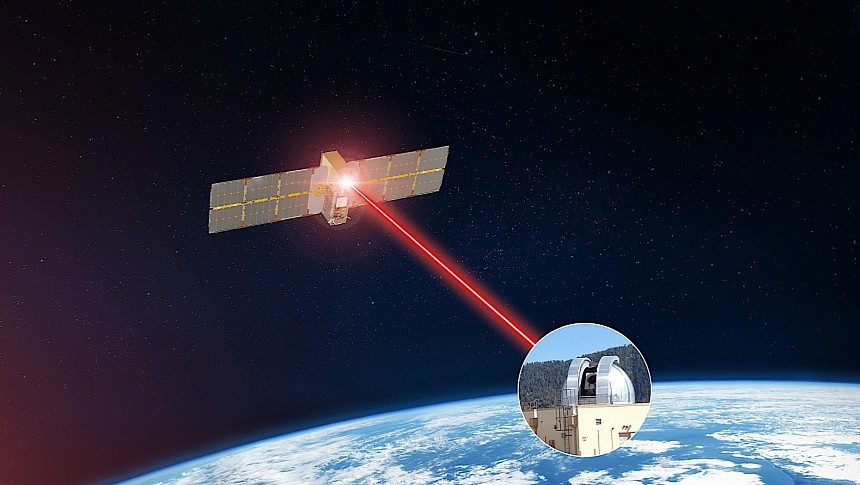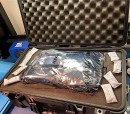Space exploration is such a fragile human activity that if a single piece of this large puzzle didn't exist, or didn't work as advertised, we wouldn't even be able to engage in dreams of alien worlds.
Take communication systems, for instance. They not only help us get in touch with the humans that have left the confines of our own planet, but are essential to telling the hardware we've spread throughout the solar system what to do, allowing us to receive data from this hardware and advance our knowledge.
At the moment, most of the comms taking place between Earth and outer space machinery happens thanks to radio technology. Just like it unfolds here on our planet, radio frequencies are used to direct rovers on Mars, get data from tiny helicopters placed on the same planet, and so on.
Radio works, but it's not very fast, and the amount of data it can send back in a given amount of time back is not very large. The tech served its purpose until now, but given how our space exploration goals have increased dramatically this past decade, a new, faster and better way of doing things is required.
Enter lasers, pieces of hardware that can send back or receive data through oscillations of light waves. And not just some data, but a lot of it.
About a year ago, a Falcon 9 rocket launched a piece of technology called TeraByte InfraRed Delivery. TBIRD for short, it's a piece of hardware no larger than a tissue box, installed in a satellite called Pathfinder Technology Demonstrator 3 (PTD-3).
A month after launch, in June 2022, TBIRD proved what it could do by sending to Earth 100 gigabits of data per second (Gbps) delivered during a period of six minutes, the time it takes the PTD-3 to pass over the receiving ground station.
At the end of April 2023, the achievement of last year was doubled, with the TBIRD sending back a staggering 200 gigabits of data per second. That's the “highest data rate ever achieved by optical communications technology,” according to NASA.
The achievement was made public by the space agency this week, and proves without a doubt that this could very well be the future of space communications. The American space agency already considers the TBIRD idea a success, and there is talk of integrating it into the design of future spacecraft and other pieces of space exploration hardware.
After all, “data from space has never had a speedier path back to Earth than this.” Ultimately, this tech could grow to being capable of sending terabytes worth of info. Just to give you an idea what that means, consider the fact a terabyte can contain 500 hours of HD videos.
At the moment, most of the comms taking place between Earth and outer space machinery happens thanks to radio technology. Just like it unfolds here on our planet, radio frequencies are used to direct rovers on Mars, get data from tiny helicopters placed on the same planet, and so on.
Radio works, but it's not very fast, and the amount of data it can send back in a given amount of time back is not very large. The tech served its purpose until now, but given how our space exploration goals have increased dramatically this past decade, a new, faster and better way of doing things is required.
Enter lasers, pieces of hardware that can send back or receive data through oscillations of light waves. And not just some data, but a lot of it.
About a year ago, a Falcon 9 rocket launched a piece of technology called TeraByte InfraRed Delivery. TBIRD for short, it's a piece of hardware no larger than a tissue box, installed in a satellite called Pathfinder Technology Demonstrator 3 (PTD-3).
A month after launch, in June 2022, TBIRD proved what it could do by sending to Earth 100 gigabits of data per second (Gbps) delivered during a period of six minutes, the time it takes the PTD-3 to pass over the receiving ground station.
At the end of April 2023, the achievement of last year was doubled, with the TBIRD sending back a staggering 200 gigabits of data per second. That's the “highest data rate ever achieved by optical communications technology,” according to NASA.
The achievement was made public by the space agency this week, and proves without a doubt that this could very well be the future of space communications. The American space agency already considers the TBIRD idea a success, and there is talk of integrating it into the design of future spacecraft and other pieces of space exploration hardware.
After all, “data from space has never had a speedier path back to Earth than this.” Ultimately, this tech could grow to being capable of sending terabytes worth of info. Just to give you an idea what that means, consider the fact a terabyte can contain 500 hours of HD videos.






